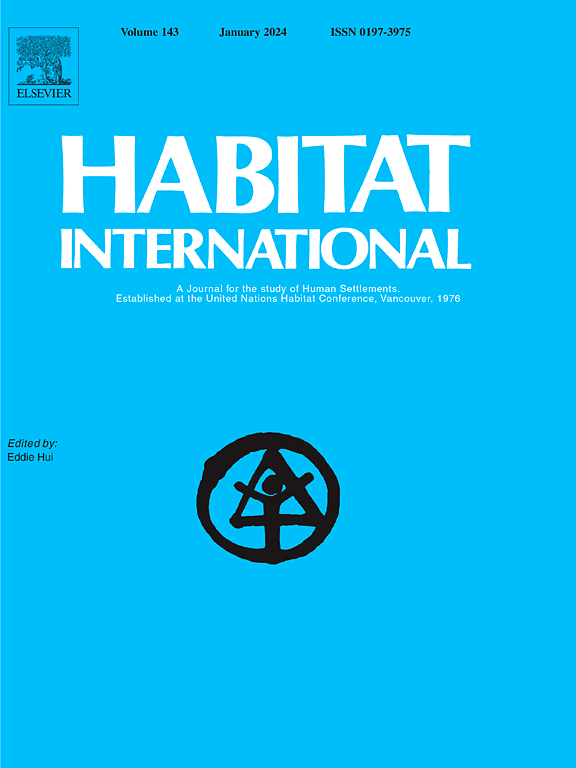乡村聚落改造项目评价及其驱动机制——基于地方利益相关者视角的动态分析
IF 7
1区 经济学
Q1 DEVELOPMENT STUDIES
引用次数: 0
摘要
乡村聚落整治是中国乡村振兴战略下的一项有效手段,旨在实现乡村可持续发展。然而,大多数研究都是从静态的角度来验证其有效机制。本文试图从地方利益相关者尤其是居民的角度来探讨RSRP的动态驱动机制。本研究以宁夏盐池县为例,结合研究调查,通过SEM模型和Fixed Effect模型的异质性分析揭示了RSRP的驱动机制。结果表明:1)农村居民满意度随着方案实施水平的提高,从2.23上升到4.12;2)居住条件、基础设施维护、环境卫生、文化建设和民主管理对当地居民满意度有正向影响。3)但其机制在RSRP时代前和时代后有所不同。更具体地说,在RSRP前,驱动力依次为:生活条件;基础设施维护;文化建设;环境卫生>;民主管理;后RSRP时代的重新排序:文化建设;生活条件基础设施维护;民主管理;环境卫生。4)相对于高收入交易对手,低收入群体在RSRP中的影响更大。它描述了农村居民对RSRP的整体发展需求,在阶段视图中以层次需求为主导。它最初是一项住区改造计划,但预计最终将以农村全面可持续发展告终,它呼吁将权力下放,从政府到社区居民来振兴农村。本文章由计算机程序翻译,如有差异,请以英文原文为准。
Rural settlement renovation program assessment and its driving mechanism: A dynamic analysis from local stakeholders’ perspective
In order to secure the sustainable rural development, Rural Settlement Renovation Program (RSRP) is targeted an effective instrument under China’ rural revitalization strategy, extensively pursed national wide. However, most of research verified its effective mechanism from a static point of view. The paper seeks to explore the dynamic driving mechanism of RSRP in the perspective of local stakeholders especially the residents. By leveraging on case study of Yanchi County, Ningxia Province, China, combined with research survey, it enables the research to disclosure the driving mechanism of RSRP through SEM model and heterogeneous analysis through Fixed Effect model. The results show that 1) the satisfaction of the rural residents level up with the scheme carry-out, rising from 2.23 to 4.12. 2) Living condition, infrastructure maintenance, environmental sanitation, cultural construction and democratic management contribute to local residents’ satisfaction positively. 3) Nevertheless, its mechanism varied in pre-era and post-era of RSRP. More specifically, in pre-era of RSRP, it is found that the driving force ordered: living condition > infrastructure maintenance > cultural construction > environmental sanitation > democratic management; which was reordered in post-era of RSRP: cultural construction > living condition > infrastructure maintenance > democratic management > environmental sanitation. 4) Low-income group is impacted greater compared to high-income counterparty in RSRP. It depicts a holistic development requirement of rural resident towards RSRP, dominant by hierarchical needs in stage-view. Initiated as a settlement renovation scheme, but expected to end with comprehensive rural sustainable development, it calls for authority decentralization in reviving rural from government to community residents.
求助全文
通过发布文献求助,成功后即可免费获取论文全文。
去求助
来源期刊

Habitat International
Multiple-
CiteScore
10.50
自引率
10.30%
发文量
151
审稿时长
38 days
期刊介绍:
Habitat International is dedicated to the study of urban and rural human settlements: their planning, design, production and management. Its main focus is on urbanisation in its broadest sense in the developing world. However, increasingly the interrelationships and linkages between cities and towns in the developing and developed worlds are becoming apparent and solutions to the problems that result are urgently required. The economic, social, technological and political systems of the world are intertwined and changes in one region almost always affect other regions.
 求助内容:
求助内容: 应助结果提醒方式:
应助结果提醒方式:


